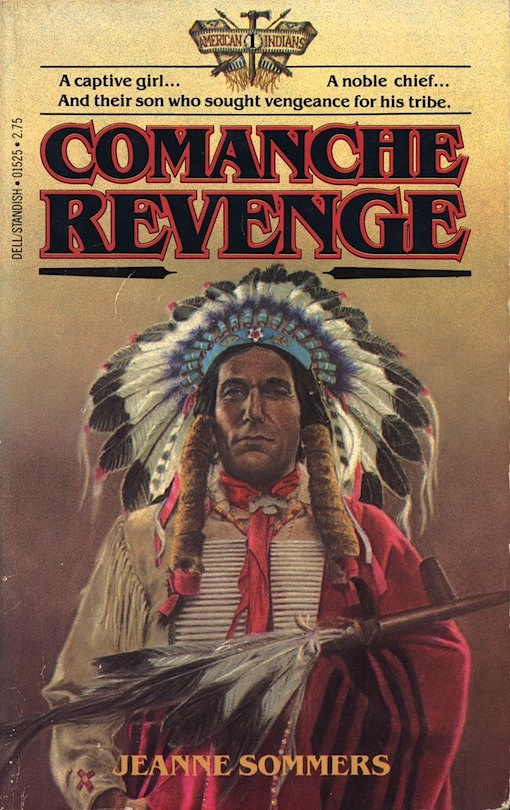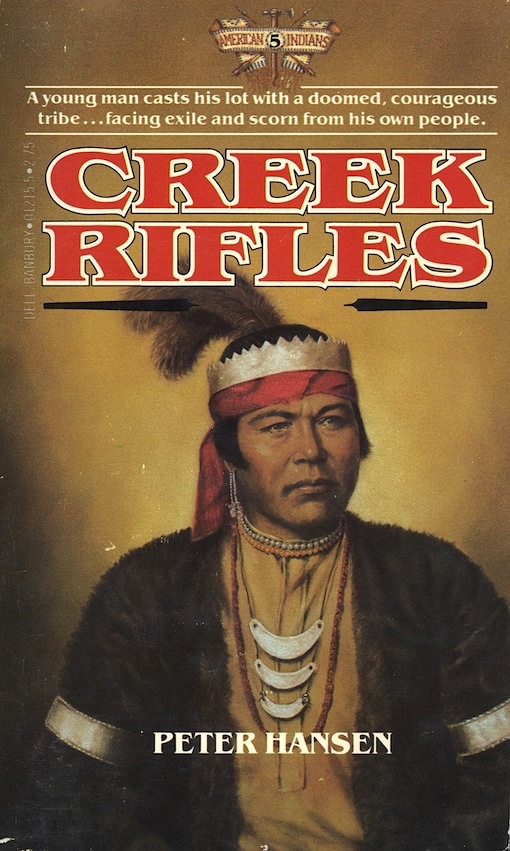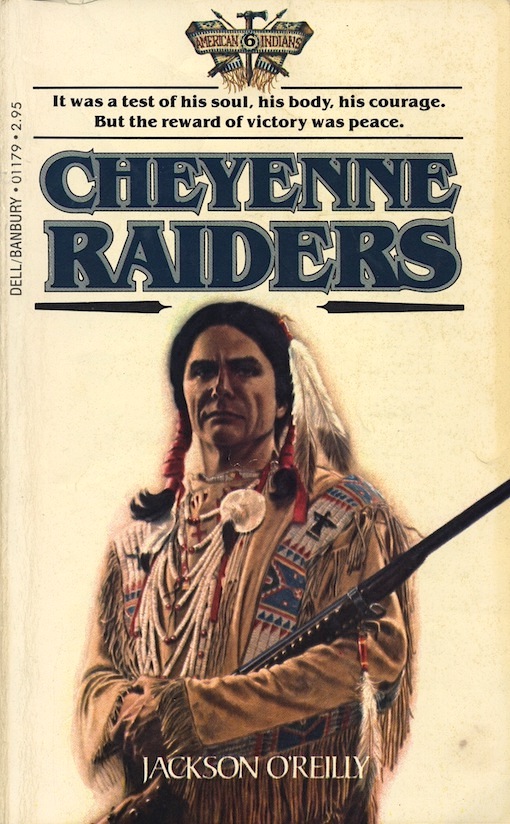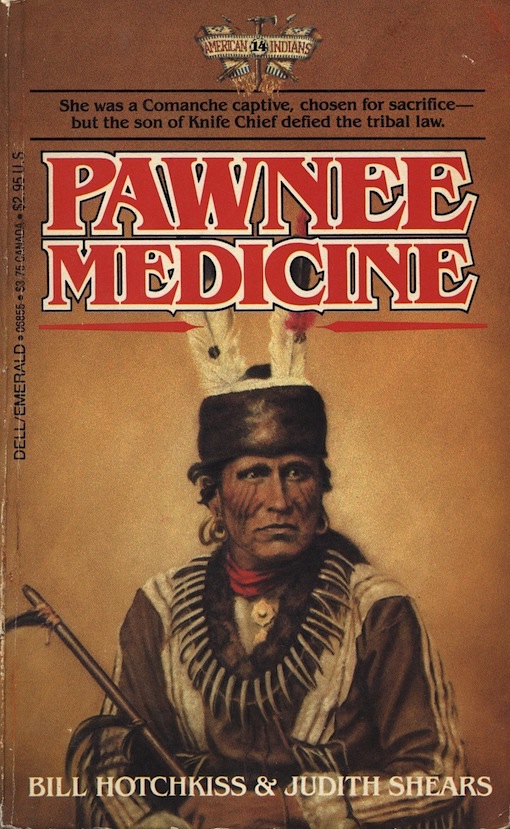The first ART book I ever bought was The McKenney-Hall Portrait Gallery of American Indians. It was published in 1972 by Crown (above is a cropped image of the front cover). I have always been fascinated by early American History as well as art and illustration and this book gave me a unique window into both worlds. The book contained 125 color portraits of some of the most famous Indians in American History, reproduced as they were painted more than 180 years ago by a special group of commissioned artists under the auspices of the War Department. The accompanying modern text was written by James D. Horan, an award winning historian and novelist, and it was definitely engrossing, but it was the colorful portraits that seized my attention the most. I was soon using them as subject matter to try and further my drawing skills.
Here's a colored-pencil drawing I did based on a portrait from the McKenney-Hall Portrait Gallery of American Indians.

And here's that portrait: Paytakootha, or Flying Clouds, a Shawnee of the Chillicothe tribe, painted by Charles Bird King, circa 1820's.
Here's another colored-pencil drawing of mine based on a portrait from the McKenney-Hall Portrait Gallery of American Indians.
And here's that portrait: Yahahajo, a Seminole Chief, as painted by Charles Bird King in 1825.
IT WAS about a year ago when I discovered Dell's intriguing American Indians historical fiction series. I was doing my typical browsing in a used bookshop when I noticed a row paperbacks with uniform spines. When I looked at their actual cover art I was instantly reminded of the great portraits from the McKenney-Hall book, and instantly impressed. But only four of the fourteen covers had an artist's signature visible and at first I couldn't quite decipher them, but with a little more discernment and some digging around I came up with a credible name: James Louis Mathewuse.
I was unfamiliar with Jimmy Mathewuse (1938- ) but as it turns out he has quite the resume. He started out in the 1960's as a charcoal and pastel portrait painter in Miami and Tampa with a predilection for painting celebrities; President Kennedy, Robert Kennedy, Roy Rogers, Nelson Rockefeller, Ed McMahon and Liberace are just a few of the famous people he painted, but quite a few regular folks were immortalized too.
In 1976, Mathewuse started producing book covers for most of the major paperback publishers in New York, representing historicals, mysteries, thrillers, westerns, contemporary novels, teen novels and biographies. Of special note is his more than 250 covers for Bantam's Sweet Valley High and Sweet Valley Twins bestselling 1980's teen romance series. In 1980, master realist painter Peter Caras took Mathewuse under his wing and taught him the medium of oil. Caras's encompassing influence can be seen somewhat in Mathewuse's great American Indians covers but not so much in his other work; as Mathewuse's career developed he became very much his own man.
* * * * *
NINE different authors contributed to the fourteen volume American Indians
paperback
series that Mathewuse produced the cover art on, and each book is classified as historical fiction, but based
entirely upon real events, accounts and people.
Unique to volumes 1-7, and 10, are maps depicting the territorial range of each Indian Nation. The series has not been professionally reviewed online that I'm aware of, and the level of writing probably does vary from book to book, but the one book I did read was not only well-written and informative (leaning towards romance), but it was engaging too, so I'm willing to believe the rest are too.
Unique to volumes 1-7, and 10, are maps depicting the territorial range of each Indian Nation. The series has not been professionally reviewed online that I'm aware of, and the level of writing probably does vary from book to book, but the one book I did read was not only well-written and informative (leaning towards romance), but it was engaging too, so I'm willing to believe the rest are too.
Comanche Revenge by Jeanne Sommers, Volume 1 in the American Indians series, was published in August, 1981, by Dell Standish. The cover art is by James Mathewuse. Jeanne Sommers is a pseudonym of Barry Myers, who also wrote under the names Lee Davis Willoughby and Jonathan Scofield. Myers' credits include several volumes in Dell's The Making of America and Freedom Fighter historical series, and two volumes in the Preacher's Law western series. Myers also wrote several standalone historical novels.
'Based upon the actual Accounts of the men and women who lived on the American frontier. Comanche Revenge is the Story of a single Indian tribe and its struggle for survival on the Western plains. Cynthia Ann Parker, The daughter of white settlers, was captured by the Comanches when she was only nine years old. She and a friend, fourteen-year-old Beth Hutchens, were the sole survivors of a raid that wiped out their families and destroyed their homes. But Cynthia Ann found a new life among the Comanches. She learned their language, adopted their ways and , in time, fell in love with their greatest young warrior, Peta Noconi. And she would bear a son, Quanah Parker, who would lead a new nation of the Indian people. This is the story of their struggles and hardships; of the dwindling hopes for a people overwhelmed by the craving for land; and of a proud tribe determined to survive despite all obstacles. This is the gripping saga of the COMANCHE REVENGE.'
Blackfoot Ambush by Catherine Weber, Volume 2 in the American Indians series, was published in October, 1981, by Dell Standish. The cover art is by James Mathewuse. There doesn't seem to be any personal information about the author Catherine Weber online, or even if she has written other novels.
'The story of the Blackfoot nation and the man who came to know their ways. In 1868 the Blackfoot reservation was a place seething with danger and discontent. An Indian agent named Silvers had been murdered. His corpse was found scalped. And the Blackfoot were accused. The proud Indian chief Flying Hawk tried to maintain peace, while his hot-blooded son Many Arrows called for war. And a beautiful woman, Patricia Ashley, turned the heads of men who jealously fought for her hand. At first, Cole Sykes seemed an unlikely man to handle the job of Agent to the Blackfoot. Gunfighter, killer, one-time prisoner, he was a hot tempered outlaw with a blazing gun. But with the help of scout Sam Ross, Sykes begins to learn the Blackfoot ways. When the theft of a herd of horses sparks a Blackfoot ambush, only his cool response and quick gun avert disaster. And his love for the beautiful Patricia Ashley promises a future for the man who once faced a life in prison.'
Crow Warriors by Bill Hotchkiss, Volume 3 in the American Indians series, was published in December, 1981, by Dell Standish. The cover art is by James Mathewuse. Poet, publisher, editor, and teacher Bill Hotchkiss's first historical novel, The Medicine Calf (1981), about the life of fur trader, explorer, and mountain man Jim Beckwourth, was nominated for a Pulitzer Prize. Hotchkiss died in 2010 at the age of 74, but he left us in good standing with fifteen excellent western novels and five books of poems.
'Kidnapped by a band of Pawnee braves, a beautiful and innocent Mormon girl is forced to become the half-slave, half-wife of a powerful warrior. Terrified by her captors, overwhelmed by her Indian husband and awed by the world in which she has to live, Chastity Cosgrove survives from day to day. Though lost, the girl is not forgotten. Mormon scout and trapper, Aloysius Benton, and his Cfow son, Big Dog, vow to rescue Chastity. Passion and violence merge as Big Dog confronts the seductive white woman's Pawnee husband. Love and hate erupt in their escape. And then Big Dog disappears, convinced that Chastity cannot live with him in the wilderness. CROW WARRIORS is the story of a brave young woman's search for the only man she loves.'
Chippewa Daughter, Volume 4 in the American Indians series, was published in February, 1982, by Dell Standish. The cover art is by James Mathewuse. Jane Toombs wrote approximately 100 novels under a variety of pseudonyms as well as her own name before her death in 2014 (age unknown). They were mostly romances and paranormal romances but she also wrote nearly a dozen historical novels. Some of the pen-names she used were Rebecca Drury, Lee Davis Willoughby, Diana Stuart, Jane Anderson, Ellen Jamison and Olivia Sumners.
'Among the Chippewa, by the cold northern shores of Lake Kitchigami, a woman named Birch Leaf dreams of a man-bear who thrusts out a flaming hand... It is the promised vision from the animal spirits, a sign that she can now be married... but the dream means nothing to her until that day when she meets a lone white man... Young, still inexperienced in the ways of the wilderness, Flann O'Phelan is in search of the vicious French-Indian Henri Fontenac... a supplier of guns to the Chippewa. Their conflict reaches its dramatic climax as O'Phelan discovers his most valuable ally, the beautiful, green-eyed Birch Leaf, a woman who knows the ways of the forest and the customs of the ancient Chippewa nation... a woman who captures the secret love of the the young adventurer and teaches him the meaning of her trust and the harsh laws of survival in an unfamiliar and untameable land... the land of the CHIPPEWA DAUGHTER.'
Creek Rifles by Peter Hansen, Volume 5 in the American Indians series, was published in April, 1982, by Dell Banbury. The cover art is by James Mathewuse. Peter Hansen is an apparent pseudonym of David Moltke-Hansen, a curator, or perhaps now retired curator, of the Southern Historical Collection at the University of North Carolina's Wilson Library. It would appear that Creek Rifles is his only novel to date.
'For the Creek Indian nation, it was the cruelest journey-- the great migration from the land they called their home to the harsh frontier. Theirs was a trail marked by bloodshed, sorrow and loss, a trail of bitter tears. Few white men were rash enough to share their terrible journey... and yet there was one. His name was Moultrie Ravenel. White, southern, well-educated, an Indian agent, he alone had to face ruthless land speculators, plantation owners and profit makers, and discover the true depth of their limitless greed. The trail he travels is the trail of the Creek people. His only reward-- the love of the beautiful and spirited Moon Shadow. Though thousands die on the long march to Arkansas, their graves marked with circling vultures, Ravenel keeps an unspoken pledge of love-- learning at last the true measure of his commitment to the people whose sorrow he shares and to the woman he loves.'
Cheyenne Raiders by Jackson O'Reilly, Volume 6 in the American Indians series, was published in June, 1982, by Dell Banbury. The cover art is by James Mathewuse. Jackson O'Reilly is a pseudonym of James Oliver Rigney, Jr. (1948- 2007), who is better known to readers worldwide by yet another pseudonym, that of Robert Jordan, the author of the bestselling epic fantasy series The Wheel of Time.
'Thomas McCabe was a white man-- a visitor to the land of the Cheyenne, intent on a single mission. He believed he could reconcile the warring tribes... and bring them peace. But this was a land that could not countenance peace-- a land that tested each man by its own savage rules. And before Thomas McCabe could marry the Indian woman he loved, he had to learn those rules... and call on his courage... in the most grueling test of a man's endurance ever devised... the ritual Sun Dance torture. A young warrior, Three Hatchets, challenged him. A proud Cheyenne chief put him to the test. And as Thomas McCabe hung from the lodgepole, delirious with the fierce agony of his trial, a spirit vision came to him, stronger than the vision of any Cheyenne warrior... a vision that would ultimately change the ways of these proud people and earn, for him, the name Cheyenne McCabe...'
Cherokee Mission by Karl H. Meyer, Volume 7 in the American Indians series, was published in August, 1982, by Dell Banbury. The cover art is by James Mathewuse. Karl H. Meyer is also credited with writing five paperback novels for Manor Books: The Bloodiest Bivouac (1978, a war novel); Crack in the Wall (1978, a war novel); Sitting Ducks (1978, a war novel); The Next Bullet (1978, a western); The Bishop's Room (1978, a mystery novel).
'Born a Cherokee, daughter of a wealthy land-owner, Agatha Lake fell in love with John Parker, the proud, young printer who came to court her. But when her people were uprooted by his, herded from their homes and driven like cattle on the bitter trail westward, she turned away from the man she loved, leaving the land of her birth... Hers was a journey of sorrow along a trail of tears... a journey that would leave a nation divided and its people helpless. But John Parker would follow at last, pursuing the harsh and relentless trail as he discovered at last what it meant to be a Cherokee... to love... and to play his part in a mission that promised no return.'
Apache War Cry by Donald Porter, Volume 8 in the American Indians series, was published in October, 1982, by Dell Banbury. The cover art is by James Mathewuse. Donald (Clayton) Porter is a pseudonym generally associated with Noel B. Gerson, the prolific writer of more than 300 fiction and non-fiction books. If you liked Gerson's bestselling 28 volume White Indian fiction series (Bantam), subtitled The Colonization of America, then you'll probably understand what Gerson has in store for you here.
'A powerful and moving drama of the American Indian tribes, APACHE WAR CRY, is Donald Porter's towering saga of the great Apache chief, Mangas Colorados-- the most respected leader of his time. At the height of his power, Mangas gathers one of the greatest forces ever seen, yet his words and actions are tempered by his love for a white woman and his respect for a single white man. Apache War Cry is his story, and it is the story of the men and women who shape his life and change his world. Above all, this is the story of the Apache themselves-- of men like Victorio, Cochise and Geronimo-- of their lives and traditions, their courage and their cowardice, as they learn the limits of white men's justice and fight for the lands of their ancestors.'
Sioux Arrows by Donald Porter (Noel B. Gerson), Volume 9 in the American Indians series, was published in December, 1982, by Dell Banbury. The cover art is by James Mathewuse.
'To the tribes of the Sioux nation, the treaty at Fort Laramie in 1866 could have meant the beginning of a new era of peace. But for the Army men who touched pen to paper, the treaty was only the beginning of a new drive westward along the Bozeman trail. Fifty thousand immigrants would pass along the trail that year of decision, driving the buffalo from the land of the Sioux... For Chief Red Cloud, it was time to endure the Sun Dance, seeking the vision that would make his people strong and unite the tribes. But another decision awaited him-- to decree a marriage between No Water and Black Buffalo Woman, forging the bond between two rival bands of Sioux warriors... It was a marriage that a young brave named Crazy Horse would never forgive. Maddened by his thwarted love for Black Buffalo Woman, dedicated to the fierce cause of the Kit Foxes, he was a demon in his hatred of the white man-- and his name became legendary as he fought for the lands of the Sioux.'
Nez Perce Legend by Mick Clumpner, Volume 10 in the American Indians series, was published in February, 1983, by Dell Banbury. The cover art is by James Mathewuse. C. R. "Mick" Clumpner is a published poet and the author of these six western novels: Six Who Died Young (Ace, 1978); Ketch Rope (Ace, 1978); Outlaw's Gold (Zebra, 1980); Broncbuster (Zebra, 1980); The Half-Breed (Signet, 1982); Massacre at the Gorge (Signet, 1982).
'Proud and independent, the Nez Perce were the most ancient Indian tribe in the Northwest. Hunters, traders and trappers, they were famed for their swift, fine horses-- the envy of every white man who came west. It was 1838 when the young Indian agent Donald Laird first came to Nez Perce lands. At the great Wyoming Rendezvous he met the young trapper William Craig who would be his guide across the vast lands. And it was there he firs set his eyes on Sun-in-the-Morning, beautiful daughter of Chief James of Lapwai. But the untried young man would have to prove himself, and Sun-in-the-Morning knew that years might pass before the white man's ways would be accepted by her tribe... and before he would accept the love she offered. Nez Perce Legend is the powerful, enthralling story of those two young trappers and the proud, beautiful Nez Perce woman who led them to the heart of her people. It is the timeless saga of the great, unclaimed West, of the white people who came to a new world... and of a journey that led over the mountains to the grassy valley of the Waillatpu.'
Kiowa Fires by Donald Porter (Noel B. Gerson), Volume 11 in the American Indians series, was published in April, 1983, by Dell Banbury. The cover art is by James Mathewuse.
'As the great buffalo herds dwindled from the Western plains, men told stories of the few, legendary white buffalo that still eluded the hunters' rifles. To hunter Jack McCall, the great white beasts represented a fortune in prize pelts-- enough wealth to begin a new life with the beautiful Sally Rawls. With the ruthless Skinner Kincade at his side, McCall set out to find the elusive white herd... and win the fortune that promised him freedom. But they had reckoned without the challenge of the Kiowa people-- and the fury of a great warrior who would fight to the the death for the mystical spirit of the white buffalo. In a hunt that would tax the limits of each man's endurance, for a reward more precious than life itself, the powerful Lone Wolf matched every fiber of his wits and skill to conquer the hunters who challenged his land... A story of idealism, love and courage-- a triumphant saga of unparalleled bravery and endurance-- KIOWA FIRES is a moving testament to the pride of a threatened people and a victory of their spirit.'
Shoshone Thunder by Bill Hotchkiss & Judith Shears, Volume 12 in the American Indians series, was published in June, 1983, by Dell Banbury. The cover art is by James Mathewuse. Judith Shears co-wrote this and Volume 14 with colleague Bill Hotckkiss, but as a solo writer she completed only one other historical novel that I know of, The Russians, published by Dell Emerald in 1984.
'He came in the winter of 1849-- a time of fierce rivalry between Indian tribes, when biting, icy winds brought the grim reminder that food was scarce. But for Johnny Elk Calls, educated far away among the white men, the Shining Mountains were the fulfillment of a dream vision, a return to the land of his youth. Seeking the roots of his heritage, he came to bring peace to the warring Shoshone and Blackfoot nations. As Elk Calls challenged the crazed Blackfoot warrior, Young Otter, to a battle of courage and wit, he found his heroism tested in a battle that left the young Blackfoot scarred for life. And in his love for a beautiful young shaman, New Grass Wind, Elk Calls learned at last the true measure of his commitment to the Shoshone people... and pledged his life to their desperate cause with the sacred bond of his marriage.'
Arapaho Spirit by Jane Toombs, Volume 13 in the American Indians series, was published in August, 1983, by Dell Banbury. The cover art is by James Mathewuse. This is Jane Toombs' second and final entry in the AI series.
'On November 13, 1833, mountain man Broken Hand Fitzpatrick rescued a four-year-old boy from the warring tribes of Arapaho and Crow. For the little boy, there was only the distant memory of his mother, Elizabeth Hampton Abbott-- and of her dying pledge of vengeance on the Arapaho man who was once her captor. It would be many years before young Hampton Abbott returns as Indian agent to the Arapaho territory, and no one but Broken Hand Fitzpatrick recognizes the boy he had rescued long ago. But the memory of a mother's words returns to possess the young man, as Hampton Abbott renews the pledge to search for the Arapaho man who haunts his destiny... his own true father, Bad Hawk. Only the love of the woman warrior Stands Shining reminds the Indian agent of his debt to the Arapaho people. Torn between his duty to the "bluecoat" policy and his debt to the Arapaho tribe, Hampton Abbott finally pursues the "medicine way" toward a lasting peace... winning the honor of an Indian name and the love of a woman in his father's tribe.'
Pawnee Medicine by Bill Hotchkiss & Judith Shears, Volume 14 in the American Indians series was published in October, 1983, by Dell Banbury. The cover art is by James Mathewuse. This is second entry in the AI series by this writing pair, and it brings the series to a close.
'In the summer of 1820, the Spaniard Antonio Behele and mountain man Termite Joe Hollingback returned to the Pawnee village at the headwaters of the Republican River, where they would meet the powerful warrior Pitalesharo, the son of Knife Chief and blood brother to Antonio Behele. And it was there they would find Little Green Frog of the Comanche, captured by the jealous warrior Hawk Foot-- a woman condemned to die as sacrifice to the Pawnee god Morning Star... But Pitalesharo would defy a medicine man's power to return the beautiful Little Green Frog to the land of her people. And he would face the vicious wrath of Hawk Foot-- a man bent on stirring hatred among the Pawnee people. From the farthest reaches of the Shining Mountains to the High Plains of the Comanche, Pitalesharo would pursue a dream that held meaning for all the Pawnee-- one man's journey in search of an undying love... and a lasting peace for all the Indian tribes.'
* * * * *
WHILE researching James Mathewuse, I learned that he has produced approximately 450 book covers, which prompted me to look through my own paperback collection to see if I had any covers by him that were unbeknownst to me. And yes, not surprisingly, I found quite a few. Along with a dozen or so Nancy Drew covers (Mathewuse apparently painted scores of them), I also discovered dozens of Dell's Scene of the Crime & Murder Ink mystery series that were published in the early 1980's. Those items, a uniquely designed paperback series that I've always admired for its aesthetics and sometimes contents, were a most pleasing revelation.
If you've always wanted to have one of the best portrait artists in America do you or a loved one proud then look no further than Jimmy Mathewuse. He's still accepting commissions at www.JimmyArt.com. You can also see a smattering of what else he's done in portraiture, publishing and Native American art.
[© March, 2018, Jeffersen]





























No comments:
Post a Comment